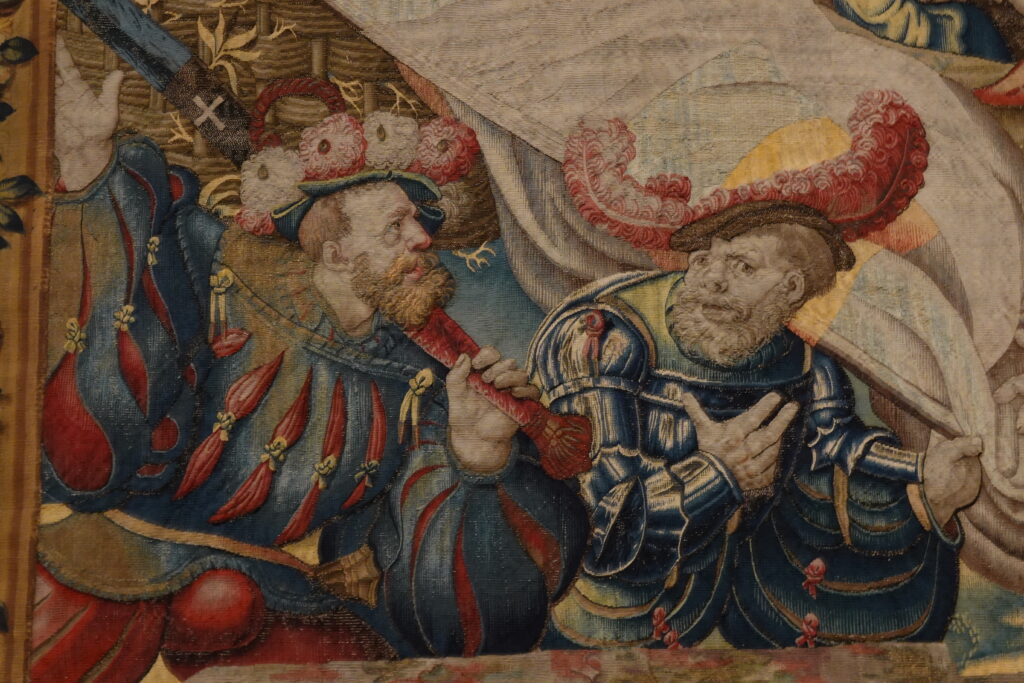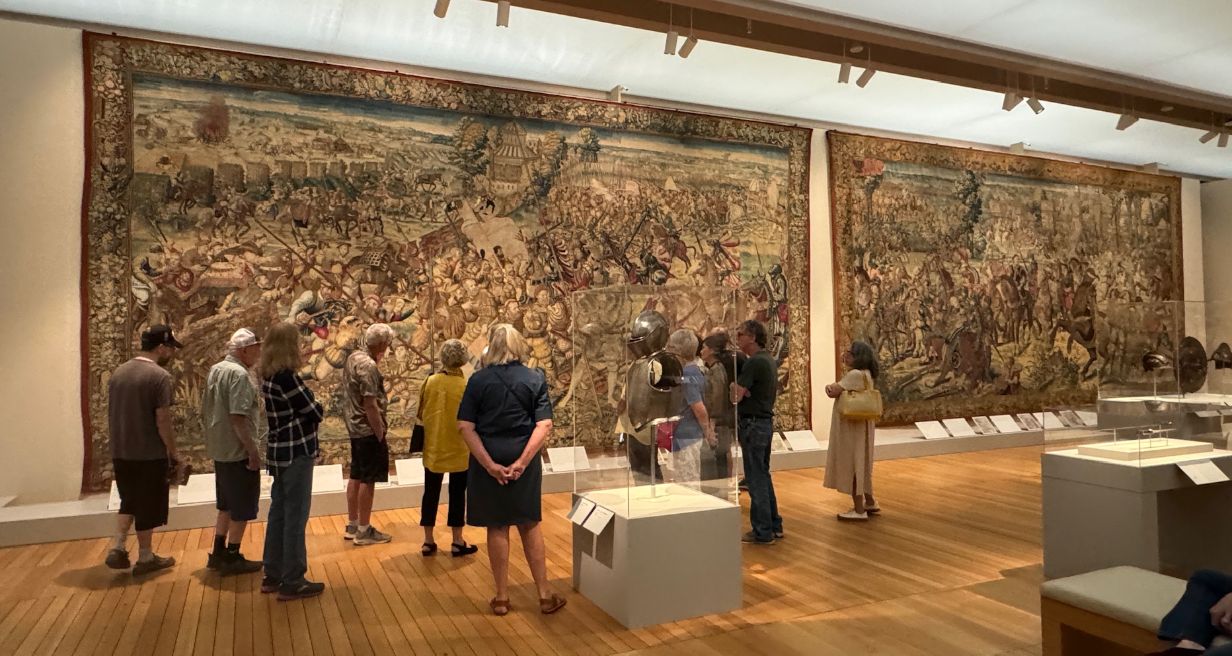The Kimbell Art Museum has a very special Italian treat in store this summer, and it’s not gelato. Seven of the most gigantic tapestries ever created are on loan from a museum in Naples.
They commemorate a pivotal battle in the year 1525, which occurred in Pavia, 22 miles south of Milan. At that time the area was contested between France (led by King Francis), and the Holy Roman Empire (led by Emperor Charles V). King Francis made the mistake of personally leading his troops. He was captured and held captive for year. But the main result of the battle was the triumphant success of the Empire, which controlled most of Europe for a long time afterwards.
The so-called Low Countries (such as modern-day Belgium) were the centre of tapestry-making in Europe, and they were under the control of Charles V. Six years after the battle, Charles was given the most extraordinary commemoration of any battle in Europe up to that date: the seven Battle of Pavia tapestries. Each is 436 x 818 cm (14.3 x 26.8 feet). While not the largest ever created (the catalogue for the exhibit shows one from the year 1520 now in a Madrid museum that is 500 x 865 cm), the combined effect of the seven tapestries in one room is overwhelming.
Set your phone camera to wide-angle just to capture one of them. To record just some of the details in the set, I took 200 photos. I was expecting the catalogue to include a large number of such close-ups. Each tapestry is given a separate chapter that shows the entire scene, and just one full-page feature image. There are also six double-page spreads dotted throughout the book, plus one single-page image, showing a central scene from the tapestries. But there is much more detail that could have been shown. Pages 126-197 are devoted to the arms and armour that are shown in display cases at the Kimbell. All of these are also on loan from the Capodimonte Museum in Naples, which I visited in 2023.
As for the individual chapters, each also has a one-page description, but the information displays in front of each tapestry at the Kimbell are really superior. The displays include a scene and a detailed description of the action in each one, often describing the names of the people depicted. There are typically 5 or 6 for each tapestry. The museum curators at the Kimbell must be given the highest accolades for the manner of presentation.
Background chapters on the Pavia set, in the catalogue, are of the highest calibre. The opening chapter is by Sylvain Bellenger, Director Emeritus of the Capodimonte. He offers a brief survey of the upcoming chapters. One is on the sources available to the man who created the ‘cartoons’ (or drawings) for the tapestries: Berbard van Orley’s cartoons are now at the Louvre. Too bad these were not also available for display here. Emma de Jong, a member of the American Friends of the Capodimonte, goes into detail about the drawings. “The tapestries identify key players by means of inscriptions and heraldic symbols. These are not present in the drawings.” Elements of lesser importance are also rendered in an unrefined manner. Even so, the reproductions here show they are major works of art in their own right.

The creator van Orley is given a chapter of his own. Thomas P. Campbell (Fine Art Museums of San Francisco) gives us beautiful imagery of his other major works. His style, Campbell writes, was heavily influenced in the late 1510s and early 1520s by German works (especially that of Dürer, who met van Orley), and the Italian works of Raphael. It was at this time that works by Raphael entered the Low Countries as cartoons to be turned into tapestries. The super-sized tapestry I mentioned in a Madrid museum was designed by van Orley.
We also get a very personal view of the tapestries in Campbell’s chapter. “According to no less a figure than Martin Luther, the subject of the Pavia tapestries was awkward for Charles [the Emperor] because he did not want to appear to rejoice in the misfortune of another prince [the King of France]. The set was not among those that Charles took with him to Spain. Rather, it remained in the keeping of Mary of Hungary and was displayed on occasion by her.” Campbell tells us that these tapestries “embody an artistic and technical achievement that was a tipping point in the art of tapestry weaving.”
Carmine Romano, curator of the Capodimonte Museum, shows in his chapter how museums over the years have displayed the tapestries. Images from 1908, 1927, 1957, 1998 and 2022 show them on the walls of first the Museo Nazionale di Napoli and then the Museo e Real Bosco di Capodimonte. The fact they have survived for 500 years is remarkable. The story of their conservation is told in a chapter by Graziella Palei.
From the most blood-thirsty depictions of fallen soldiers to the inclusion of a mysterious owl; from the grandeur of a castle to an idyllic pastoral scene in the distance; from the extraordinary costumes worn by some warriors to the horrific scene of soldiers drowning in a river; and from an amusing scene of a parrot in a gilded cage to the sadness of fallen horses: these tapestries are not just a commemoration of a key battle in European history, but a distillation of what it meant to be alive in 1525. A superb exhibit, which gets a perfect 10-star rating from this reviewer.
Events this weekend:
Head to the museum on Friday, July 12, at 6 pm for a lecture titled “The Art of War in the Renaissance: Technology, Tactics, and the ‘Face of Battle,’” presented by Clifford J. Rogers, professor of history for the United States Military Academy at West Point. Then, on June 13, at 2 pm there will be a historical fencing demonstration from the Valiant School of Arms. This live demonstration will highlight tactics, arms, and armor from the history of Italian swordplay.
The Pavia tapestries will be on display until Sept. 15, 2024
The catalogue is available at the Kimbell gift shop for $60.
website: kimbellart.org
Images: Lead photo shows two of the tapestries, with a group studying one of them. A suit of armor is seen in a display case.
Second photo: detail from one of the tapestries shows two soldiers on the French side of the battle in conversation.
